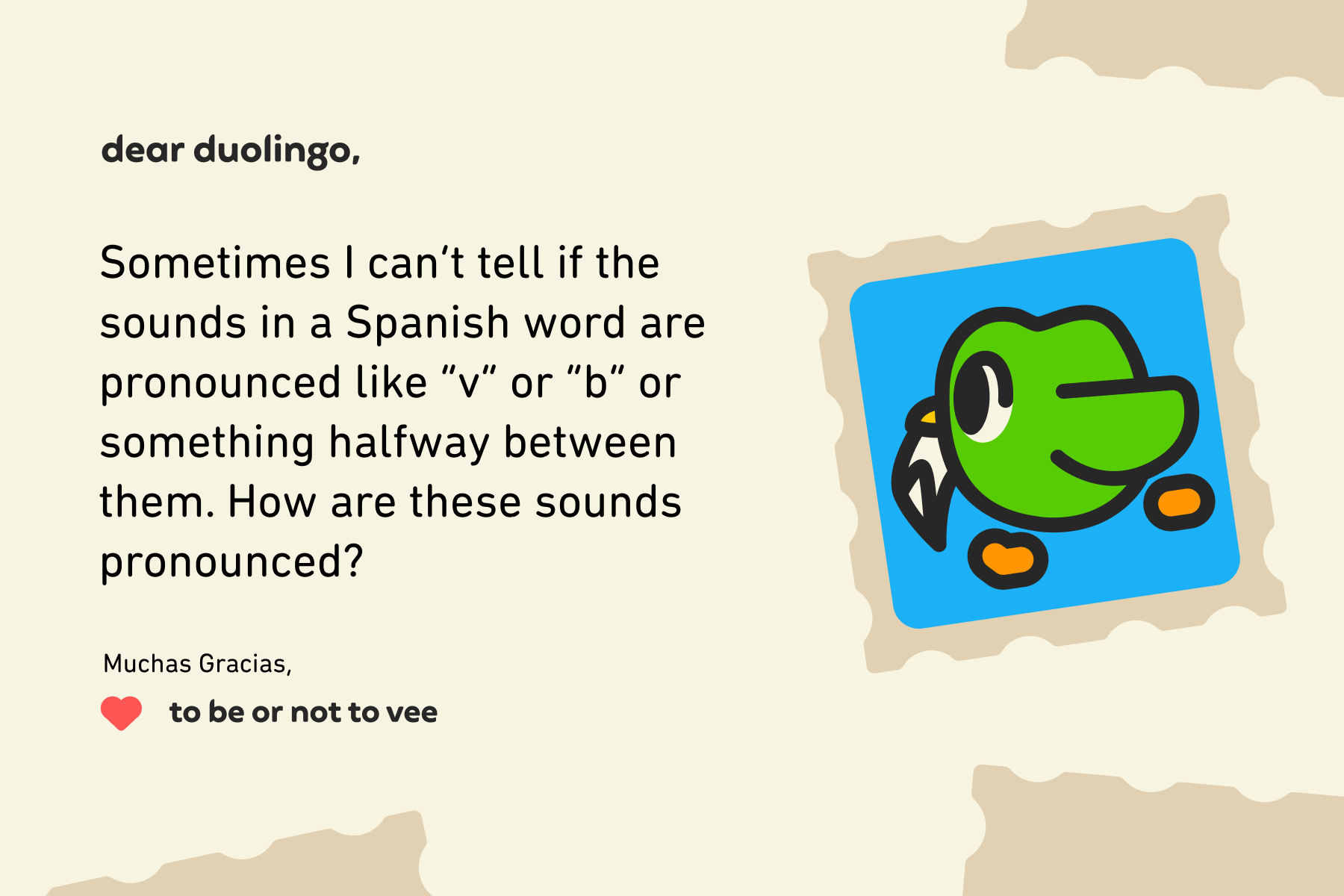Welcome to another week of Dear Duolingo, an advice column just for language learners. Catch up on past installments here.
¡Hola, amigos! We are Dr. Farrah Neumann and Dr. Fernando Melero-García, and together we’re leading Dear Duolingo this week! You might recognize Farrah as the learning scientist behind our discussion of Chinese tones and how to accurately hear and pronounce them. Fernando’s background is in Hispanic linguistics, and as a curriculum designer, he develops content for the Duolingo Spanish course and thinks a lot about how to make it engaging and effective.
We both have backgrounds in researching and teaching Spanish pronunciation so this week we're taking over Dear Duolingo to answer a common question about Spanish pronunciation!
Here's this week's question:

Alright To Be or Not to Vee, prepare to become a better vetter (and pronouncer!) of Spanish sounds. You may already know a lot about Spanish pronunciation, but today we’ll dive into detail about two specific letters in Spanish that often throw learners for a loop: "b" and “v."
There's good news and bad news. Good news first: The answer to this week’s question is incredibly simple… “b" and “v" sound identical to one another! Yes, that’s right—each of the word pairs below sound exactly the same, even to lifelong Spanish speakers!
| Written with "b" | Written with "v" |
|---|---|
| bello (beautiful) | vello (hair) |
| tubo (tube) | tuvo (he/she had) |
| bienes (assets) | vienes (you come) |
| ¡Basta! (Enough!) | vasta (vast) |
Because "b" and "v" sound exactly the same, it’s not unusual for people to mix them up, the same way English speakers mix up "there" and "their" because they sound identical. It’s just like how English speakers never misunderstand the meanings of rough vs ruff (although the dog-related puns can be downright rufffff).
Alright, that brings us to our bad news… Although “b" and “v" make the same sound, that's not the whole story. 😬 We'll get into the details below, but here's the most important thing to remember: When in doubt, just pronounce them both like English “b.”
For intermediate Spanish learners: behind the scenes of "b" and "v"
Ok, so now you know that "b" = "v" in Spanish, but there's another detail to keep track of! These letters can make 2 different sounds, depending on where the letter is in the word. This is like how in English we pronounce "t" at the beginning of words differently than when it's in the middle of a word (like "tap" versus "butter"). Here's how it works in Spanish:
B/V #1: The most common pronunciation
Most of the time, Spanish “b” and “v” are pronounced differently from the typical English pronunciation of "b." For the Spanish sound, the lips come close to touching but they don’t quite touch, like how "w" is pronounced in English. The next time you hear a word like habitación (room) or avión (plane) in a lesson, you may notice that it’s softer than our English "b." This is probably why To Be or Not to Vee asked if there might be some sort of in between pronunciation: They were hearing this more relaxed “b/v” sound!
B/V #2: The (easy!) exception
The second “b/v” sound in Spanish is a sound you already know and love from English—it's the same as English "b"! This is the pronunciation you'll use at the very beginning of a sentence or after a pause. For instance, imagine you want to say something like "Well… let’s go" with a little pause in between “well” and “let’s go.” In Spanish, you would say Bueno… Vámonos. Since the "b" in bueno is at the very beginning of the sentence, and the "v" in vámonos is after a pause, you will pronounce both letters the same way: by making your upper and lower lips touch, just like in the English "b." There are a couple of other exceptions, too, but this is the main one for learners to keep in mind!
If you are wondering why Spanish has these two different letters that sound the same, but that change in different contexts, it's because languages change over time and how we speak today reflects centuries of small changes! But it's also because all languages have these nuanced pronunciation rules—we just never have to think about them in languages we grow up using! (Like, have you ever thought about when to make a puff of air in English?)
Be more confident about "b" and "v"! 🐝
Now that you know that "b" and "v" are pronounced the same, you can speak Spanish more confidently and listen out for the subtle difference in kinds of "b/v"! Remember, when in doubt, err on the side of saying “b.” Even just knowing what to listen for will go a long way in understanding more Spanish.
For more answers to your Spanish pronunciation and general language questions, get in touch with us by emailing dearduolingo@duolingo.com.



